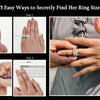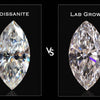
What is Diamond Fluorescence
Table Of Contents
What is the Fluorescence of a Diamond?
When exposed to the diamonds under UV light, fluorescent diamonds contain particles that give off a visible (typically blue) glow. Although fluorescence rarely affects a stone's beauty or sparkle and can even make some lower colors (I, J, K, L, etc.) look more colorless or white, it can occasionally cause stones to appear milky or hazy. However, fluorescent diamonds are typically less expensive and, as long as the effect is not immediately apparent, may represent good value.
More uncommon than diamonds with a strong or extremely strong fluorescence are those with no or very little fluorescence.
However, a more fluorescent diamond also glows in the natural sunlight, and this can be perceived as undesirable in a white diamond. Fluorescence does not affect the natural appearance of the diamond for diamonds with slight or no fluorescence.
Approximately one-third of all diamonds exhibit some fluorescence, with 95% of them emitting a blue hue. Green and yellow fluorescence diamonds are also possible, though they are much less common than those with a blue hue.
Although fluorescence is one indicator or grading factor for diamonds, a diamond's appearance is not always affected by its presence.
What Does It Mean When Diamonds Glow in the Backlight?
Fluorescence is the scientific term for the phenomenon that causes the glow of diamonds under black light. This substance is present in about 35% of diamonds that are grown naturally, and it causes 95% of them to glow bullishly under a black light. The remaining 5% could glow in a range of different hues, such as red, yellow, white, green, and orange.

The GIA or AGS grades the fluorescence intensity as part of the grading process, assigning it one of five ratings: none, faint, medium, strong, or very strong. The fluorescence in the latter two categories can occasionally be seen in sunlight, which can give the diamond a cloudy or blurry appearance.
The Meaning of Diamond Fluorescence
Carbon has crystallized into a diamond. This process takes place between 75 and 125 miles below the earth's surface, typically in areas with active volcanoes or old volcanic sites. A diamond will turn fluorescent if boron mineral traces are present in the earth at the time of crystallization.
Blue is the most common color to fluoresce in diamonds, though they can also fluoresce in yellow, green, orange, and white. According to estimates, 10% of all diamonds fluoresce strongly enough to noticeably alter the diamond's color when viewed in sunlight or incandescent (low UV) light, while approximately 50% of all diamonds exhibit fluorescence that can be observed under special circumstances, such as under a long-wave UV lamp.
The GIA categorizes diamond fluorescence into five levels, including none (i.e. no fluorescence), faint, medium, strong, and very strong. The GIA Gem Trade Laboratory asserts that neither color nor clarity can be determined solely by fluorescence intensity. In other words, it is possible for two diamonds to have the exact same fluorescence intensity despite having completely different clarity and color grades.

What Influences Diamond Fluorescence on Appearance?
Those who dispute the idea that fluorescent diamonds are less desirable make the following arguments:
- Since diamonds under UV light are uncommon in viewing environments, it makes sense to grade color in actual lighting;
- It is incredibly uncommon to find haziness in highly fluorescent diamonds;
- Fluorescence occasionally raises color to the level of the human eye, enhancing the diamond's beauty.
According to a GIA study from 1997, fluorescence typically has no effect on a diamond's appearance when it is facing up. In fact, they discovered that when viewed table-up, strongly blue fluorescent diamonds appeared to have a better color appearance than non-fluorescent diamonds.
So, good or bad? What about diamond fluorescence? That depends, I guess. When they don't fluoresce, the more expensive diamonds (large and high color, think D-E-F) are much more valuable.
Can Fluorescence Affect the Price of the Diamond I've Chosen?
Due to the fact that diamonds in grades K to M have a slight yellow tint, fluorescence in these diamonds can raise their price. In this case, blue fluorescence balances the yellow tint and gives the diamond a whiter appearance. A diamond's level of fluorescence ought to be noted on the certification. The GIA diamond certification report categorizes fluorescence levels in diamonds as None, Faint, Medium, Strong, and Very Strong.
Although fluorescence in diamonds can be viewed negatively and can lower the stone's price, these characteristics are rarely affected by fluorescence and remain desirable.
Because fluorescence can be difficult to detect, diamonds with a Faint grade won't be negatively impacted. The effects of fluorescence are very unlikely to diminish the beauty of the stone, even for diamonds with a Medium grade. Most diamonds with a Faint or Medium grade can be used to make genuinely beautiful diamond engagement rings or wedding rings.
More on the Types of Diamond Fluorescence
Fluorescence diamonds go by the following names:
- None fluorescence
- Faint fluorescence
- Medium fluorescence
- Strong fluorescence
- Very strong fluorescence
Here are the various types of diamond fluorescence grades. No fluorescence comes first.
1. What is a Diamond Without Fluorescence?
The surfaces of this diamond exhibit no fluorescence and no blue ultraviolet reflective lights. A fluorescence diamond is one that has no fluorescence. Therefore, in general, when diamonds receive no fluorescence grade, it is obvious that the stone does not reflect blue light. This fluorescence grade costs more than it does in reality.
A diamond without fluorescence has no reflection of blue light in a dark environment, which lowers its price. As a result, no fluorescence diamond can be purchased for a high price and still be valuable.
I color-grade diamonds, for instance.
2. What Precisely is a Faint Fluorescence Diamond?
A diamond with weak fluorescence emits 10% more blue light in the ultraviolet than a diamond with no fluorescence. A diamond fluorescence scales as a faint strong blue fluorescence diamond when it reflects a very small amount of blue color light that is discernible. The lights are emanating from a weak diamond that fluoresces, suggesting that the buyer would undoubtedly buy it. The rule does not apply here.
A diamond is said to have faint fluorescence if its surface faintly reflects blue light, which is not visible in sunlight but is visible in ultraviolet rays. Since faint fluorescence diamonds reflect less blue light and can sparkle with a rainbow of white light colors, they are relatively easy to find.
M color Diamond, as an illustrative example.
3. What is a Diamond With Medium Fluorescence?
The blue color light glitters more strongly in medium fluorescence diamonds than it does in non-fluorescent and faintly fluorescent ones. The medium fluorescence diamond exhibits a more intense blue color reflection. The appearance of lights in medium diamond fluorescence makes it easy to see in ultraviolet light. As a result, a medium fluorescence diamond appears to be a fluorescence machine that is blue in color.
J Color Diamond as an illustration.
4. What is a Medium Fluorescence Diamond?
When compared to non-fluorescent and barely fluorescent diamonds, the blue color light glitters more prominently in medium fluorescence diamonds. More intense blue color reflections can be seen in the medium fluorescence diamond. When exposed to ultraviolet light, it is simple to see thanks to the appearance of lights in medium diamond fluorescence. As a result, the blue-colored fluorescence machine appears to be a medium fluorescence diamond.
Strong blue fluorescence indicates that there is more light reflection from the diamond in the ultraviolet spectrum in a dark environment. Strong blue fluorescence causes the diamond to release more sparkle from its anatomy, making it resemble a blazing starfish. People don't want to purchase fluorescently strong blue diamonds because doing so would detract from their appearance.
K-colored diamond, as an example
5. What is a diamond with extremely strong fluorescence?
The anatomical corners of a diamond with a very strong fluorescence glow with whitish and blue hues. Strong fluorescence on the surfaces is a reflection test and is not intended to prevent purchase. An extremely high fluorescence grade on the anatomies is a sign of extremely strong light reflection, even in the absence of daylight.
However, a very strong fluorescence diamond is actually less expensive than it appears to be because consumers are aware that fluorescence detracts from the diamond's appearance. As a result, 10% less than its actual price was charged by diamond sellers and manufacturers for the extremely strong fluorescence diamond.
Strong fluorescence-grade diamonds should not be purchased because they emit more blue light when they spark and obscure the diamond's natural light reflections, such as its rainbow color. Strong fluorescence-grade diamonds must therefore not be purchased.
For instance, an H-color diamond.
Final Words
It's crucial that you're satisfied with the diamond you buy. As demonstrated, fluorescence can significantly improve the color and appearance of a diamond, so it shouldn't be viewed negatively. It is only very infrequently that fluorescence will make a diamond appear milky, greasy, or hazy. Although making the right choice is always subjective, the best course of action would be to speak with a diamond expert before making a purchase.
Leave a comment
Please note, comments must be approved before they are published.









